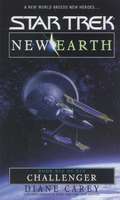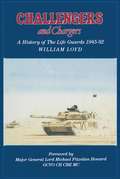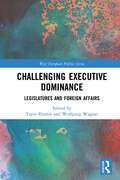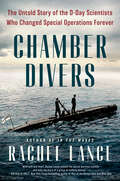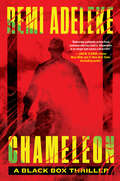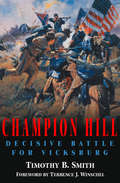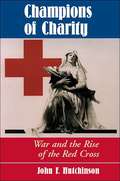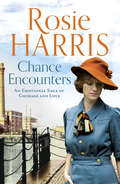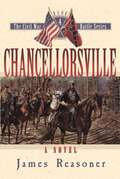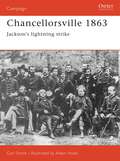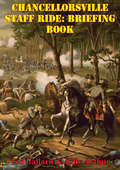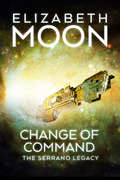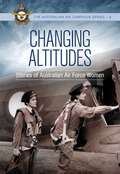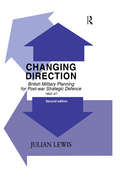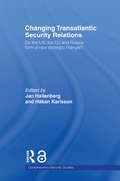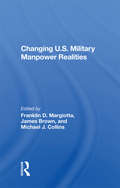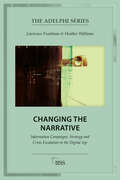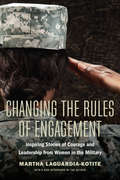- Table View
- List View
Challenger: New Earth #6 (Star Trek: The Original Series #94)
by Diane CareyFar from the reaches of the Federation, the Starship Enterprise has been guiding the development of an obscure planet upon whose fate the future of the entire galaxy may now depend in this unforgettable Star Trek adventure. As the crew of the Starfleet Enterprise&’s time leading the colony on newly discovered planet comes to an end, they look forward to giving up control to another ship and crew. But when the new ship arrives in the midst of a deadly attack on the colony, it&’s tragically destroyed. With the Starship Enterprise off fighting a new and powerful enemy that threatens the colony as well as its enemies, Commander Nick Keller, first officer and ranking survivor of the decimated crew, is marooned. He must find a way to complete his original mission and come to the aid of the Enterprise in what might be its most desperate hour.
Challengers and Chargers: A History of the Life Guards, 1945–92 (Military History Ser.)
by William LloydThis history of the Life Guards traces the regiment's story right to the end of its existence and its amalgamation with the Blues and Royals.
Challenging Executive Dominance: Legislatures and Foreign Affairs (ISSN)
by Wolfgang Wagner Tapio RaunioBringing together scholars from Europe and North America, this book examines the engagement of legislatures across the world in foreign and security policy. The articles are specifically chosen to cover the whole range of foreign affairs questions from crisis management and military missions, arms trade, the Common Foreign and Security Policy (CFSP) of the European Union (EU), international energy agreements, to international trade negotiations. Drawing on a principal-agent framework, the book challenges the conventional wisdom of ‘executive autonomy’ in foreign affairs, with parliaments using multiple ex ante and ex post instruments to monitor, oversee and control governments in external relations. Moving beyond the ‘politics stops at the water’s edge’ image, the articles highlight the role of party-political contestation instead of consensus in the name of national interest structuring parliamentary debates and decision-making in this increasingly politicized issue area. Considering the lack of research on parliamentary participation in foreign affairs beyond the specific case of the U.S. Congress, the book will also contribute to theory building and will deepen our understanding of legislative-executive relations. The chapters originally published as a special issue in West European Politics.
Chamber Divers: The Untold Story of the D-Day Scientists Who Changed Special Operations Forever
by Rachel LanceThe previously classified story of the eccentric researchers who invented cutting-edge underwater science to lead the Allies to D-Day victoryIn August 1942, more than 7,000 Allied troops rushed the beaches of Normandy, France, in an all but-forgotten landing. Only a small fraction survived unscathed. It was two summers before D-Day, and the Allies realized that they were in dire need of underwater intelligence if they wanted to stand a chance of launching another beach invasion and of winning the war.Led by the controversial biologists J. B. S. Haldane and Dr. Helen Spurway, an ingenious team of ragtag scientists worked out of homemade labs during the London Blitz. Beneath a rain of bombs, they pioneered thrilling advances in underwater reconnaissance through tests done on themselves in painful and potentially fatal experiments. Their discoveries led to the safe use of miniature submarines and breathing apparatuses, which ultimately let the Allies take the beaches of Normandy.Blast injury specialist Dr. Rachel Lance unpacks the harrowing narratives of these experiments while bringing to life the men and women whose brilliance and self-sacrifice shaped the outcome of the war, including their personal relationships with one another and the ways they faced skepticism and danger in their quest to enable Allied troops to breathe underwater.The riveting science leading up to D-Day has been classified for generations, but Chamber Divers finally brings these scientists&’ stories—and their heroism—to light.
Chameleon: A Black Box Thriller (Black Box #1)
by Remi Adeleke“Delivering authentic action from someone who has lived it, Chameleon is on target and scores a direct hit!” —Jack Carr, former Navy SEAL and #1 New York Times bestselling authorFrom filmmaker, memoirist, and former Navy SEAL Remi Adeleke, on the heels of his featured roles in the hit film Plane and in Fox’s Special Forces: World’s Toughest Test, comes the first installment in the pulse-pounding Black Box Thriller series, featuring Nigerian-born and New York-raised Kali Kent and the top-secret Black Box program—perfect for readers of Jack Carr, Mark Greaney, and Brad Taylor. When a mysterious former South African commando, Lucas Van Groot, begins taking wealthy hostages all over the world, it appears at first to be a typical ransom gambit. However, it soon becomes clear that his “Hostage Inc.” venture is manipulating worldwide stock markets and threatening global economic collapseEnter Black Box, the CIA’s elite, secret special operations branch—so surreptitious that not even the Director of CIA is fully privy to the unit’s activities. Black Box is composed of highly skilled agents who perform with precision: Chameleons who can transform into myriad characters, Ghosts who are specialists in stealth and surveillance,Wind operatives who are transportation experts, andAberration agents whose specialty is deep cover for years.Kali Kent, a Nigerian born and Bronxite Chameleon in the Black Box program, leads the hunt for Van Groot. Tracking this ringleader and his cadre of international criminals, the team discovers the South African mastermind is after a much larger prize and the race is on to prevent a worldwide tragedy.Along the way, Kali will have to face the demons from his childhood and reflect on his emotional path that made him the Chameleon that he is today.
Champion Hill: Decisive Battle for Vicksburg
by Timothy B. Smith Terrence J. WinschielThe Battle of Champion Hill was the decisive land engagement of the Vicksburg Campaign. The May 16, 1863, fighting took place just 20 miles east of the river city, where the advance of Gen. Ulysses S. Grant's Federal army attacked Gen. John C. Pemberton's hastily gathered Confederates. The bloody fighting seesawed back and forth until superior Union leadership broke apart the Southern line, sending Pemberton's army into headlong retreat. The victory on Mississippi's wooded hills sealed the fate of both Vicksburg and her large field army, propelled Grant into the national spotlight, and earned him the command of the entire US armed forces.Timothy Smith, who holds a Ph.D. from Mississippi State and works as a historian for the National Park Service, has written the definitive account of this long overlooked battle. His vivid prose is grounded upon years of primary research and is rich in analysis, strategic and tactical action, and character development. Champion Hill will become a classic Civil War battle study.
Champions of Charity
by John F. HutchinsonA character in an Evelyn Waugh novel once remarked that "There’s nothing wrong with war--except the fighting. ” In Champions of Charity, John Hutchinson argues that while they set out with a vision to make war more humane, the world’s Red Cross organizations soon became enthusiastic promoters of militarism and sacrifice in time of war. The mass armies of the nineteenth century were stalked by disease and slaughtered by ever more destructive weaponry, arousing the indignation and humanitarian concern of self-appointed battlefield Samaritans, who envisioned a neutral corps of volunteer nurses who would aid and comfort wounded soldiers, regardless of nationality. But the champions of charity soon became champions of war. Florence Nightingale was among the few at the time to recognize the dangers lurking in the Red Cross vision. She refused to join, and warned its founders that the governments of the world would cooperate with the Red Cross because "it would render war more easy. ” She was right; starting in the late 19th century armies simply used the Red Cross to efficiently recycle wounded men back into the frontlines. In World War I, national Red Cross societies became enthusiastic wartime propagandists. This was true in every combatant nation, and it is a transformation well portrayed by the fascinating selection of art in this book. Soon Red Cross personnel were even sporting military-style uniforms, and in the United States, the Red Cross became so identified with the war effort that an American citizen was convicted of treason for criticising the Red Cross in time of war!The Red Cross played an especially important role in encouraging the mass involvement of women in the "home front” for the first time. It did this through magazines, postcards, posters, bandage-rolling parties, and speeches that blended romantic images of humanitarianism and war into a unique brand of maternal militarism. A true pioneer in mass propaganda, the Red Cross taught millions that preparation for war was not just a patriotic duty, but a normal and desirable social activity. The Red Cross societies had proven their usefulness in mobilizing civilians in wartime, and most of their functions were taken over by government agencies by the time of World War II. Gradually the Red Cross became better known for its work in public health, disaster relief, and lifesaving classes. But the legacy of a darker past still lingers: the red cross on a white background found on army ambulances, or the unsubtle subtext of sacrifice and heroism in Red Cross television advertising. It is a legacy the Red Cross itself has preferred not to acknowledge in its own self-congratulatory literature. For not only was the humanitarian impulse that inspired the creation of the Red Cross easily distorted, but this urge to militarize came from within its own ranks. This startling and provocative history of the Red Cross reminds us of the hidden dangers that sometimes come cloaked in the best of intentions.
Champions of Charity: War and the Rise of the Red Cross
by John HutchinsonIn Champions of Charity, John Hutchinson argues that while they set out with a vision to make war more humane, the world's Red Cross organizations soon became enthusiastic promoters of militarism and sacrifice in time of war.The mass armies of the nineteenth century were stalked by disease and slaughtered by ever more destructive weaponry, arousing the indignation and humanitarian concern of self-appointed battlefield Samaritans, who envisioned a neutral corps of volunteer nurses who would aid and comfort wounded soldiers, regardless of nationality. But the champions of charity soon became champions of war.Florence Nightingale was among the few at the time to recognize the dangers lurking in the Red Cross vision. She refused to join, and warned its founders that the governments of the world would cooperate with the Red Cross because “it would render war more easy.” She was right; starting in the late 19th century armies simply used the Red Cross to efficiently recycle wounded men back into the front lines. In World War I, national Red Cross societies became enthusiastic wartime propagandists. This was true in every combatant nation, and it is a transformation well portrayed by the fascinating selection of art in this book. Soon Red Cross personnel were even sporting military-style uniforms, and in the United States, the Red Cross became so identified with the war effort that an American citizen was convicted of treason for criticizing the Red Cross in time of war! The Red Cross played an especially important role in encouraging the mass involvement of women in the “home front” for the first time. It did this through magazines, postcards, posters, bandage-rolling parties, and speeches that blended romantic images of humanitarianism and war into a unique brand of maternal militarism. A true pioneer in mass propaganda, the Red Cross taught millions that preparation for war was not just a patriotic duty, but a normal and desirable social activity.The Red Cross societies had proven their usefulness in mobilizing civilians in wartime, and most of their functions were taken over by government agencies by the time of World War II. Gradually the Red Cross became better known for its work in public health, disaster relief, and lifesaving classes. But the legacy of a darker past still lingers: the red cross on a white background found on army ambulances, or the unsubtle subtext of sacrifice and heroism in Red Cross television advertising.It is a legacy the Red Cross itself has preferred not to acknowledge in its own self-congratulatory literature. For not only was the humanitarian impulse that inspired the creation of the Red Cross easily distorted, but this urge to militarize came from within its own ranks. This startling and provocative history of the Red Cross reminds us of the hidden dangers that sometimes come cloaked in the best of intentions.
Chance Encounters
by Rosie HarrisA chance meeting will change her life in ways she never could have imagined in this emotional saga set during World War II from the author of Love or Duty. As the Second World War continues to bring heartache to those left behind in Liverpool, Megan Lloyd is determined to do her bit for the war effort. She is appalled by the plight of young women left pregnant and destitute following ill-fated love affairs with passing sailors or American GIs, and establishes a place of refuge for unmarried mothers. But Megan&’s plan incurs her father&’s intense disapproval and she finds herself cast out from the family and unprepared for the challenges ahead. Her new life is full of trauma, drama and heartbreak, but can she find joy and love as well?
Chancellorsville
by Stephen W. SearsA new look at the Civil War battle that led to Stonewall Jackson&’s death: A Publishers Weekly Best Book of the Year and &“tour de force in military history&” (Library Journal). From the award-winning, national bestselling author of Gettysburg, this is the definitive account of the Chancellorsville campaign, from the moment &“Fighting Joe&” Hooker took command of the Army of the Potomac to the Union&’s stinging, albeit temporary, defeat. Along with a vivid description of the experiences of the troops, Stephen Sears provides &“a stunning analysis of how terrain, personality, chance, and other factors affect fighting and distort strategic design&” (Library Journal). &“Most notable is his use of Union military intelligence reports to show how Gen. Joseph Hooker was fed a stream of accurate information about Robert E. Lee&’s troops; conversely, Sears points out the battlefield communications failures that hampered the Union army at critical times . . . A model campaign study, Sears&’s account of Chancellorsville is likely to remain the standard for years to come.&” —Publishers Weekly &“The finest and most provocative Civil War historian writing today.&” —Chicago Tribune Includes maps
Chancellorsville (The Civil War Battle Series, Book #4)
by James Reasoner[FROM THE BACK COVER] SEVERAL Yankees burst out of the shelter of the trees and ran toward him. Will fired coolly into their midst, dropping a couple of them. A bullet kicked up dust at his feet as the remaining Union soldiers tried to draw a bead on him. Then, with a Rebel yell, Darcy Bennett bolted past him, followed by several more soldiers of the company. The Yankees abandoned their position and turned to run back into the woods. Darcy and the others piled in after them. Will turned to see the rest of the company entering the woods as well. He stalked on toward the trees, reloading his pistol as he went. He reached the edge of the woods and stepped into the shadows. What sunlight reached the ground was filtered through the new leaves that clustered thickly on the branches of the trees, giving everything a greenish cast as if the men were doing battle underwater. And as if they were underwater, everything seemed to slow down for Will. He found a target, fired, twisted, fired again, heard a muffled shout and wheeled to his left to see one of the Yankees lunging at him, rifle upraised so that he could drive his bayonet down into Will's body. Will lifted his saber and the Yankee ran into it, spitting himself on the blade. Momentum carried him forward, though, and the tip of his bayonet raked across Will's left hip. Will shoved the dying man aside and ripped his blade from the Yankee's body. He stumbled a little from the pain that burned in his hip from the bayonet gash, but he was able to keep his feet and shoot another blue-clad attacker. The tide of battle swept on past Will, surging deeper into the woods. He leaned against one of the trees and holstered his pistol, then shoved the saber back in its sheath. He could feel blood trickling warmly down his leg now. He pulled his shirt loose from his trousers, ripped a piece off the bottom of it, and folded the cloth into a compress. He took off his belt, snugged it lower around his hips so that it would hold the compress in place against the wound, then limped forward.
Chancellorsville 1863
by Carl Smith Adam HookOsprey's examination of the Battle of Chancellorsville (1863) of the American Civil War (1861-1865). Following the debacle of the battle of Fredricksburg in December 1862, Burnside was replaced as commander of the Army of the Potomac by General Joseph Hooker. Having reorganised the army and improved morale, he planned an attack that would take his army to Richmond and end the war. Although faced by an army twice his size, the Confederate commander Robert E. Lee split his forces: Jubal Early was left to hold off Sedgwick's Fredericksburg attack, and 'Stonewall' Jackson was sent with 26,000 men in a wide envelopment around Hooker's right flank. This title details how at dusk on May 2, Jackson's men crashed into the Federal right flank, and how stiffening Federal resistance slowed the Confederate advance the next day.
Chancellorsville Staff Ride: Briefing Book [Illustrated Edition]
by Ted Ballard Billy ArthurContains more than 20 maps, diagrams and illustrationsAlthough "Fighting Joe" Hooker skillfully executes a well-conceived plan and out-flanks his adversary, months of offensive planning are shelved as he suddenly orders his army on the defensive. Lee seizes the initiative and achieves what has often been called his most brilliant victory. How could this happen when Hooker's army outnumbers that of Lee 2 to 1 and is far superior in artillery and logistics? Answers to these and other questions concerning leadership, communications, use of terrain, and the psychology of men in battle, are often found by personal reconnaissance of the battlefield. This book offers a staff ride briefing of Chancellorsville. Since 1906 staff rides have been used to in the education of U.S. Army officers to narrow the gap between peacetime training and war.
Chancellorsville: The Battle and Its Aftermath
by Gary W. Gallagher<P>A variety of important but lesser-known dimensions of the Chancellorsville campaign of spring 1863 are explored in this collection of eight original essays. Departing from the traditional focus on generalship and tactics, the contributors address the campaign's broad context and implications and revisit specific battlefield episodes that have in the past been poorly understood. <P>Chancellorsville was a remarkable victory for Robert E. Lee's troops, a fact that had enormous psychological importance for both sides, which had met recently at Fredericksburg and would meet again at Gettysburg in just two months. But the achievement, while stunning, came at an enormous cost: more than 13,000 Confederates became casualties, including Stonewall Jackson, who was wounded by friendly fire and died several days later. <P>The topics covered in this volume include the influence of politics on the Union army, the importance of courage among officers, the impact of the war on children, and the state of battlefield medical care. Other essays illuminate the important but overlooked role of Confederate commander Jubal Early, reassess the professionalism of the Union cavalry, investigate the incident of friendly fire that took Stonewall Jackson's life, and analyze the military and political background of Confederate colonel Emory Best's court-martial on charges of abandoning his men.
Change of Command (Familias Regnant #6)
by Elizabeth MoonTHEIR UNIVERSE IS FALLING APART! Rejuvenants fear the backlash caused by bad drugs; they want to ensure that nothing interferes with their pursuit of long life--or the profit that comes from promising it to others. Neighbor states fear the aggressive expansion of the Familias Regnant, fuelled by population growth and extended lifespan. Within the Regular Space Service, those who have received experimental rejuvenations fear they may have been given bad drugs on purpose. Esmay Suiza's family fears that her marriage to an offworlder will damage their position. Barin Serrano's family fears that his marriage to a Landbride of Altiplano will damage his career and their reputation. Fear begets violent reactions--from foreign governments, from great Families determined to maintain or increase their power, from internal rivalries in the Fleet--and nothing escapes the resultant bloodbath unscathed. As Esmay and Barin struggle to reconcile their families, others have more cosmic struggles to win.
Change of Command (Serrano Legacy #6)
by Elizabeth MoonNew York Times bestselling author of Rules of Engagement Elizabeth Moon continues her grand epic as enemies from both without and within strike at the heart of the Familias Regnant.After the suppression of the New Texas barbarians, Esmay Suiza and Barin Serrano hoped for a respite to develop their relationship. But there is time for neither rest nor pleasure as events around the galaxy push all the great powers towards war.When Speaker Lord Thornbuckle is assassinated, his daughter Brun finds herself trapped in the machinations of politics and power--with the true villain behind her father's death keeping an ever-watchful eye on her every move...Meanwhile, the shadowy criminal empire of the Benignity, having already sabotaged the controversial "rejuvenation drugs" that fuel the Familias' longevity, is now poised to spread its influence and corruption directly into Familias government.On the planet Copper Mountain, the once-hunted Pilar Bacarion has quietly assumed command of a military prison. But she has far greater ambitions in play: she will carry out Lepescu's plan to gain control of the Fleet and crack the very foundations of the government.But for Esmay and Barin, a long-forgotten betrayal is about to be revealed, a secret that in one moment entangled the fates of both the Suiza and Serrano clans--and made them mortal enemies."A thoroughly excellent adventure."--Booklist"Political intrigue, mutiny in space, and ideological battles of war and weapons lend variety to this fast-moving space opera set in the distant future."--Library Journal
Changing Altitudes: The Stories of Australian Air Force Women
by Big Sky PublishingIn the early years of the Second World War, Australian women began lobbying to contribute to the nation&’s wartime effort. From 1940, women were signing up to serve in the Royal Australian Nursing Service, and in 1941, an Auxiliary arm of the Royal Australian Air Force was established, allowing women to join on a temporary basis to enhance the organisation&’s ability to fight. In the decades since, Australian women have continued to contribute significantly to the operational capability of the world&’s second oldest air force. They have done so regardless of the social norms of the time, or the perceived limits of their abilities, always showing their detractors that they are capable of great things. &‘Changing Altitudes: The Stories of Australian Air Force Women&’ includes the personal stories of some of these women, recounting in their own words their experiences while proudly wearing the uniform of the Service. This is the second volume of the Royal Australian Air Force Oral Histories series, aiming to capture the one capability that the RAAF cannot operate without - its people.
Changing American Assessments of the Soviet Threat in Sub-Saharan Africa, 1975-1985
by Donald JordanThis work categorizes various American images of the Soviet threat in Africa and traces them over time. Four different images are examined: the alarmist, the globalist, the regionalist, and the confident regionalist. Jordan points to the importance of understanding what these images are and how they influence and determine U.S. foreign policy decisions. Will be useful to strategic theorists, Africanists, and analysts of U.S. foreign policy.
Changing Direction: British Military Planning for Post-war Strategic Defence, 1942-47
by Julian LewisThis volume records the transition from planning against any post-war resurgence of German and Japanese militarism to preparations against a possible threat from the Soviet Union. It charts Foreign Office resistance to consideration of even the possibility of Soviet hostility after the war. Changing Direction is likely to remain the standard work o
Changing Transatlantic Security Relations: Do the U.S, the EU and Russia Form a New Strategic Triangle? (Contemporary Security Studies)
by Jan Hallenberg Håkan KarlssonThis new book shows how the idea of a strategic triangle can illuminate the security relationships among the United States, the European Union and Russia in the greater transatlantic sphere. This concept highlights how the relationships among these three actors may, on some issues, be closely related. A central question also follows directly from the use of the notion of the triangle: does the EU have actor capability in this policy sphere or will it get it in the future? The reason this is so important for our project is that only if the Union is regarded by the two other actors, and regards itself, as an actor in security policy does the strategic triangle really exists. Consequently, this book has a strong focus upon the development of the actor capability of the Union. In the case of the United States, it examines to what extent the concept of the strategic triangle has significance under each of five grand strategies that serve as alternative visions of the superpower’s role in the world.
Changing U.s. Military Manpower Realities
by James Brown Michael J. Collins Franklin D. MargiottaManpower—qualified, experienced, and in adequate supply—is considered by many to be the keystone of the U.S. capability to deter or wage war. But can the all-volunteer force (AVF) continue to attract and retain the quantity and quality of active and reserve forces required to meet the security needs of the nation? The contributors to this collectio
Changing the Conditions for Development Aid: A New Paradigm?
by Niels Hermes and Robert LensinkIn 1998 the World Bank published a report entitled "Assessing Aid: What Works, What Doesn't and Why". This report presents the results of an extensive investigation into the effectiveness of development aid. The main message of the text of the report is that development aid helps, but only when there is a good policy environment in the recipient countries, that is when there is sound macroeconomic management and when robust government institutions exist. It stresses that it is a myth to think that good policies can be bought by giving development aid: giving aid conditional on policy reforms does not lead to improved economic policies. The conclusion of the World Bank report is that aid flows should be directed only to countries with sound policies and that it should be focused more on supporting governments in reforming entire sectors, rather than on specific development projects. The "Assessing Aid" report has led to heated debates, both among academics and policy-makers, about development aid and aid policies. Many have questioned the methodology used, the results and the policy conclusions of the report. This book aims to contribute to the ongoing discussion about the future of development aid. In particular, it re-examines a number of issues that are crucial to the analysis and to the conclusions of the World Bank report. In this study the authors aim to put the discussion on the future of development aid into perspective and summarise the main findings of the other studies in this collection. They focus on two issues: the aid effectiveness debate before and after the Assessing Aid report, and the discussion on policy conditionality and good governance. Section II provides a brief survey of past research on aid effectiveness, that is, before publication of the Assessing Aid report and summarises the main findings of the World Bank report on aid effectiveness. In this study the authors aim to put the discussion on the future of development aid into perspective and summarise the main findings of the other studies in this collection. They focus on two issues: the aid effectiveness debate before and after the Assessing Aid report, and the discussion on policy conditionality and good governance. Section II provides a brief survey of past research on aid effectiveness, that is, before publication of the Assessing Aid report and summarises the main findings of the World Bank report on aid effectiveness.
Changing the Narrative: Information Campaigns, Strategy and Crisis Escalation in the Digital Age (Adelphi series)
by Heather Williams Lawrence FreedmanNarratives provide the storylines of conflict and in doing so become an arena of conflict themselves. When states mount information campaigns against each other, they are trying to change the narrative. The digital platforms of the new information environment have been identified by various analysts as a significant factor in contemporary strategy and crisis management. But while social media is noisier and more chaotic than traditional media, and unprecedented in its immediacy and accessibility, has it thus far been a game changer in strategic affairs? In this Adelphi book, Sir Lawrence Freedman and Heather Williams examine the impact of state-led digital information – or disinformation – campaigns in four contexts: the India–Pakistan crisis over Kashmir in 2019; the heightened tensions between the United States and Iran following the assassination of Qasem Soleimani in 2020; China’s messaging in response to the COVID-19 pandemic from 2020–22; and the Russia–Ukraine crisis from 2013–23. While noting the meaningful consequences of digital information campaigns, in each case the authors call for a sense of perspective. Such campaigns are only one aspect of wider political struggles. They are also difficult for their initiators to control, and less likely to influence foreign audiences than domestic ones. Overall, the authors argue, there is little evidence so far to suggest such campaigns will have as much influence over contemporary crises as the classical instruments of military and economic power.
Changing the Rules of Engagement: Inspiring Stories of Courage and Leadership from Women in the Military
by Martha Laguardia-KotiteChanging the Rules of Engagement brings to life the authentic, vivid stories of leadership from inspiring and adventurous women who achieved the extraordinary by serving their country in the U.S. military. These women shattered the glass ceiling and performed extraordinary feats by refusing to take &“no&” for an answer and learning how to lead in traditionally male-dominated environments. Martha LaGuardia-Kotite skillfully captures their leadership lessons, struggles, and successes—showing how courageous and tenacious women can achieve their goals and help change policy, insights also applicable to today&’s leaders in corporate and business boardrooms. Whether soaring into outer space with the second woman to command a space shuttle or plunging to the depths of the Atlantic Ocean with a combat veteran special operations diver, these profiles in leadership highlight a range of powerful examples: from Vivien Crea, a vice commandant of the Coast Guard, who rose to the highest position of any woman in the history of the U.S. military, to Tammy Duckworth, who demonstrated her resilience after being shot down while piloting a helicopter in Iraq and went on to serve as a U.S. senator. Also included are the inspirational stories of women Marines and the first women members of the military service academies&’ gender-integrated classes, who recall the highs and lows of their trailblazing journey. Representative of a widely diverse group of enlisted women and officers of different races and cultures, these women have succeeded since the mid-1970s at combating prejudices and aiding change in the military culture with grit, intelligence, leadership, and honor.
